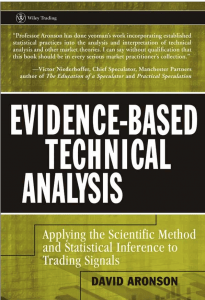About the book
The effectivity of technical trading signals is evaluated by author David Aronson, providing data and evidence about it. He evaluates the application of newly-developed statistical tests and scientific methods in assessing technical trading signals. The book includes a comprehensive discussion of the new methodology, which is particularly created to assess the performance of signals and rules that were detected by data mining.
Review
This book is right up the alley of many algorithmic traders and is actually as an introductory guide to it. The author discusses the processes in identifying trading signals, which is quite a rare find in the many finance books already published in the market. It discusses systematic trading and quant investing, too but focuses more on the process of identifying trading signals.
The book will tell readers which paths to avoid when trading and not necessarily how to profit. It only evaluates the processes that will lead to a rewarding outcome of trades. This book is recommended if you are a trader looking for a book that evaluates processes to find trading signals.
About the Author
DAVID R. ARONSON is an adjunct professor of finance at the Zicklin School of Business and taught graduate-level courses on technical analysis and data mining since 2002. He worked as a broker for Merrill Lynch in 1973-1977. In 1980, he founded AdvoCom Corporation, which is an early adopter of modern portfolio theory methods and computerized performance databases.
Table of Contents
Acknowledgments
About the Author
Introduction
PART I Methodological, Psychological, Philosophical, and Statistical Foundations
CHAPTER 1 Objective Rules and Their Evaluation
CHAPTER 2 The Illusory Validity of Subjective Technical Analysis
CHAPTER 3 The Scientific Method and Technical Analysis
CHAPTER 4 Statistical Analysis
CHAPTER 5 Hypothesis Tests and Confidence Intervals
CHAPTER 6 Data-Mining Bias: The Fool’s Gold of Objective TA
CHAPTER 7 Theories of Nonrandom Price Motion
PART II Case Study: Signal Rules for the S&P 500 Index
CHAPTER 8 Case Study of Rule Data Mining for the S&P 500
CHAPTER 9 Case Study Results and the Future of TA
APPENDIX Proof That Detrending Is Equivalent to Benchmarking Based on Position Bias
Notes
Index
